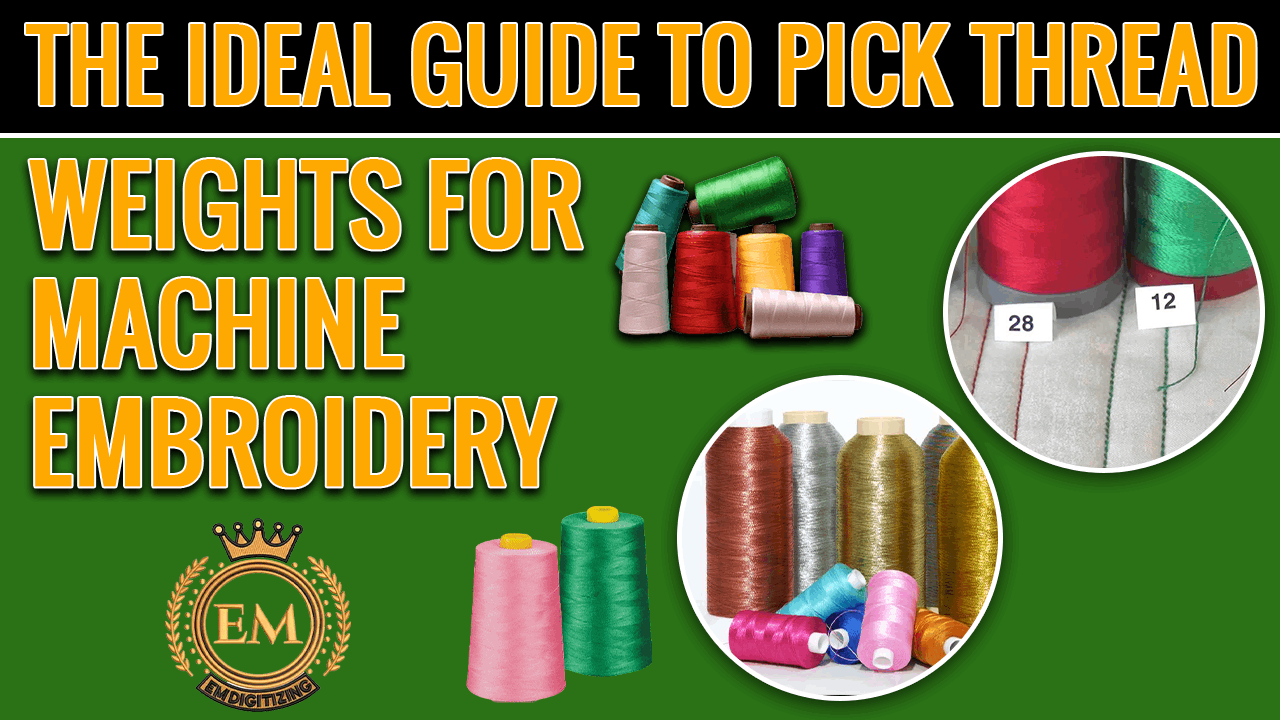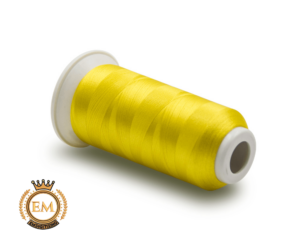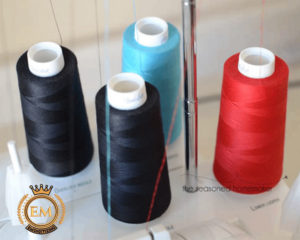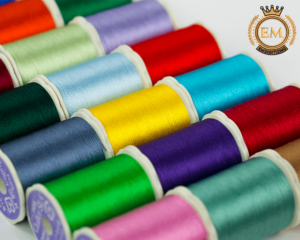Machine embroidery is interesting, but overwhelming for a newcomer. Beginners tend to ignore the significance of understanding the different machine embroidery threads type and thread weights.

Embroidery Digitizing Services
You are here because you want to know more about thread weights, their types, and all. Well, you are at the right place! In this article, we will cover polyester, cotton, silk, rayon, and thread weights for machine embroidery.
Before we jump into thread weights, it is important to understand that not all threads are similar, and not all machines are the same. Matching thread brand to machine and needle is like finding the best recipe. Few thread types and brands will work better with specific machines and needles.
It is vital to test your thread on a scrap piece of fabric first rather than on your favorite shirt. Make sure that the fabric you will be testing on is the same as the material you will use for your project. Order a small amount of thread first for proper testing to see what works best with your machine and your creative target.
Polyester Embroidery Threads:

A polyester thread is strong, colorfast, durable, and can even withstand chlorine bleach. The polyester thread gives a shine that makes your embroidery look and feels professional. This thread comes in a vast range of colors and is known to smoothly run.
It is an amazing choice for general embroidery, particularly outdoor clothing or children’s garments. We all know kids are mess-free little angels but when they do make a mess, polyester will withstand the cleaning process.
The last thing any machine wants is a thread that constantly breaks. Your machine would be happy when using polyester thread in your projects. Because polyester threads have a tendency to last long and do not break easily as compared to other threads which makes a machine run smoothly and efficiently. Though, a polyester thread should not be used for all of your projects.
Rayon Embroidery Threads:

Rayon machine embroidery threads are a common choice because it is an amazing selection of colors, even more than polyester. Its only weakness is its strength when compared to polyester. Polyester has a much highest breaking point than rayon. That is why it is important to test different rayon thread brands with your machine to see how they hold up with stitch-intensive embroidery designs and high-speed stitching.
Rayon thread performs well during highest speed stitching. It is softest than polyester and is more suitable for complex work or works with freestanding lace.
Cotton Embroidery Threads:

Where polyester and rayon pride themselves on the highest shiny look, cotton thread has a beautiful soft shine. You can order cotton threads with a matte finish to further boost your creativity. It performs well in most machines, but again, it is good to test it out to ensure it smoothly runs.
Cotton threads could be bought in standard thickness, but they also come in extremely fine varieties, suitable for complex and delicate work. Always remember that the finer the thread, the more likely it is to break while embroidering.
Silk Embroidery Threads:

Silk is rich and sought after in the fashion industry, and is considered equally rich when it comes to machine embroidery. Silk thread is strong and fine, yet has a shine and softness that is unmatchable by both rayon and polyester.
For these reasons, silk thread could be pricey, and it might be tough to get particular colors. It is the thread you would want to use for highest-end projects or embroidering on deluxe materials.
Metallic Embroidery Threads:

Metallic threads are famous for breaking during embroidery and this could cause frustration. Metallic threads give beautiful colors and shine that other threads cannot imitate, but a lot of new embroiderers are very frustrated as rethreading your machine can be an extremely irritating and time-consuming process.
This issue could be simply fixed with several adjustments to your spooling method and by ensuring the use of a needle specific to metallic thread embroidery.
They are composed of a central core that’s wrapped in metals or foils and then dyed with the desired color. These strands tend to fall apart simply, which is where the thread integrity seems to fail. Picking up the highest quality metallic threads will lessen breakage when embroidering, and are worth the extra penny.
A Brief Lesson On Machine Embroidery Thread Weights:

Let’s see where you can use thread weights.
Your standard thread will often come in a medium 40wt Thread and 50 Wt. Threads. But a big range of other threads exists in super fine 100-weight, or super chunky three-weight options as well.
Sew like a pro when you know how thread weight influences your stitching. Whether you want the thread to blend in or sparkle and show off, selecting the right thread would make all the difference in your embroidery projects.
Medium Thread Weights:

Medium thread weights are the types of threads that you would most often find, most often 40wt Thread and 50 Wt. Threads. They can be used for quilting, construction, machine embroidery, Sergers, and general-purpose sewing.
Medium thread weights are made of all types of materials including cotton, rayon, polyester, and even metallic.
This thread weight will blend or show up relying on what the fabric is made from. Hence, cotton will blend more than a metallic will. But if you actually don’t want your thread to show, you might have to consider a different weight.
Fine Thread Weights:

Fine-weight threads run from 60wt to 100wt. These small threads are perfect for complex work like micro quilting and finely detailed machine embroidery like freestanding embroidery designs or monogramming.
They can be made from cotton on the bigger end to polyester on the finer end. The fine threads blend better and take up less space, so they are perfect for hand and machine appliqué, English paper piecing, and micro quilting.
Dense quilting would as well leave quilts softer, more flexible, and lighter as the thread does not take up as much space or add as much weight.
This 80 wt polyester thread is called DecoBob and is considered the favorite piecing and bobbin thread. Because it is so fine, it makes seams lay flatter and crisper when piecing. This is particularly helpful when it comes to foundation paper piecing or when you want to precisely match up designs and blocks. It is also amazingly strong, making it a reliable choice to hold your projects and quilts together.
As a bobbin thread, it is supreme. The fine thread could be paired with any top thread including thicker threads. It amazingly lessens tension issues, lets your seams lay flatter and look more professional, and as a bonus it allows your bobbin to hold more thread as the fine thread takes up less space.
Heavy Thread Weights:

Heavyweight threads differ from 12 – 18 wt. 12wt threads can still fit through the eye of a sewing machine needle, so you can do some amazing stitching with this thickest thread whereas 8wt and heavier threads aren’t suggested as a top thread.
Use 12wt for bold machine quilting, big stitch hand quilting, thread painting, hand embroidery, big stitch hand quilting, decorative stitching, and even hemming jeans.
When using it on the machine the thicker thread will stand up from the material giving you an amazing textural effect.
8wt threads and thicker are the most commonly used for hand embroidery. Even though they are very thick to fit through the sewing machine needle, you can still do couch and bobbin work with them on a machine or use it in the loopers of a serger. It can as well be used for similar things to 12wt, additionally crochet, and knitting.
Winding Up:
That was the end of this article. We hope you now understand thread weights and types of threads. We hope you enjoyed reading this article as we did in writing.
If you want to customize embroidery logo digitizing, EM DIGITIZING will be your best choice. At EM DIGITIZING, we deliver the best embroidery logo digitizing services with the best quality. We offer 50% off on all our services to our potential customers on their first order. So, get a free quote now and we will get in touch with you.
Hope this article will be helpful for you guys!
If there’s any question related to this article feel free to comment to us. And, thanks for reading!
Weights with 40 are considered as the finer and lighter thread as compared to 60wt. The higher the number, the thinner the thread! 40wt thread must be your go-to thread for all-around everyday embroidery.
Yes, a 30 weight thread is thicker and heavier than a 50-weight thread because it is denser and takes only thirty km to equal one kg compared to 50. The fraction on the thread spool tells you the weight and the number of plies or strands twisted together.
28-weight threads are the second heaviest weight thread and are perfect for double strand cross stitch, blanket stitch, hand piecing, hand appliqué, hand quilting, machine lace, and lower looping serging.
40 weight threads are the most commonly used embroidery thread and would cover most projects, from free-hand embroidery to quilting, digitizing, to clothing construction.
The most popular cotton thread used in hand embroidery is stranded cotton, also known as embroidery floss. Stranded cotton comes in skeins, and the entire thread that comes off the skein is divisible into 6 separate, fine threads.
